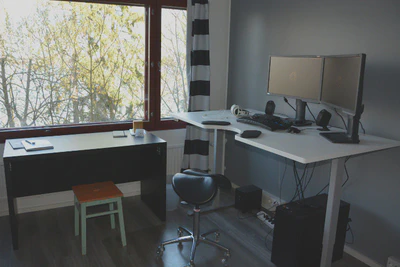
Table of Contents
Overview
Poor physical health plagues modern knowledge workers, partly due to long hours of sedentary work in anatomically incorrect positions. Consequently, knowledge workers can experience physical discomfort, pain, or even injury, which decreases their productivity and quality of life. The physical discomfort often manifests in knowledge workers in compensatory behavior such as eating highly palatable foods or excessive stimulant use to alleviate the discomfort with short-term fixes. At worst, these adverse effects can result in an inability to work and earn a living, such as chronic wrist, neck, or back pain.
We can prevent these adverse health effects by designing ergonomic workstations. An ergonomic workstation allows the worker’s posture to be in the correct form naturally, which decreases discomfort and pain, preventing injury. In an ideal ergonomic workstation, the body’s position is an active one, which increases the blood flow in the body and brain. Improved blood flow improves our focus, makes us feel less tired, and makes engaging other physical activities easier. In an ergonomic workstation, knowledge workers can work longer without discomfort, increasing their productivity. For these reasons, ergonomics should be a core value for modern knowledge workers.
The Workstation chapter discusses features of an ergonomic workstation, such as ergonomic chairs, tables, screens, and keyboards.
Standing Desk and Saddle Chair

Negative health aspects of sitting have received more attention in recent years. It can result in problems such as lower back and neck pain and decreased blood circulation. The right choice of furniture can help you to minimize these negative aspects by improving posture when sitting.
In Finland, Salli manufactures ergonomic furniture such as saddle chairs and height-adjustable tables which improve the sitting posture. As the name suggests, the saddle chair mimics how one would sit in a saddle on horseback, enhancing the lower back’s position. I use their Salli SwingFit and Salli Office products. Additionally, it is good to have a floor protector under the chair to avoid damaging the floor.
Desktop Computer
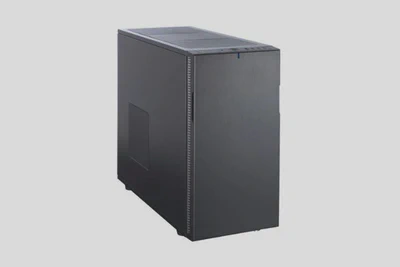
The computer should be quiet, responsive, and performant. A noisy machine is irritating and has a substantial negative impact on productivity. Since the fans and hard drives generate most of the computer noise, we should minimize their noise by choosing quiet components. Selecting the right casing also reduces noise. We can improve responsiveness by installing the operating system and software on a solid-state drive and choosing fast random-access memory and a high-performance central processing unit. We should select a graphics card that supports multiple monitors and performs well for scientific computing.
My desktop computer consists of the following components.
- Processor (CPU): Intel Core i5-7600K 3.80GHz
- Graphics (GPU): Asus GeForce GTX 1060 6GB
- Memory (RAM): G.Skill RipjawsV DDR4 3200 MHz 16 GB
- Storage (SSD): Samsung 250GB 850 EVO SSD 2.5" SATA III
- Storage (HDD): Seagate 2TB Barracuda, SATA III, 7200RPM, 64MB
- Motherboard: Asus STRIX Z270H Gaming
- Cooler: Noctua NH-U14S
- Power supply: EVGA 550W SuperNOVA 550 G3
- Casing: Fractal Design Define R5
Monitors
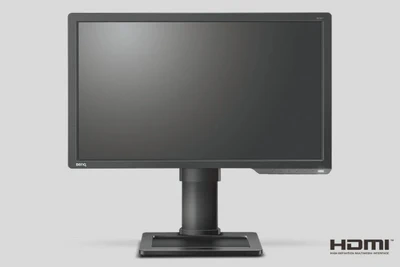
The right monitor type is also essential for the ergonomic workstation. You should be able to adjust the height, tilt, and rotate the monitor. The monitor should support an adequate color spectrum for your work and have settings for eye-friendliness, such as a lower blue-light setting and refresh rate. Height adjustability allows for a better neck position. Additionally, we can turn rotatable monitors into vertical monitors for displaying large text files. My setup includes two BenQ Zowie 24-inch monitors. However, I would recommend buying at least 27-inch monitors if your budget allows it.
Keyboard
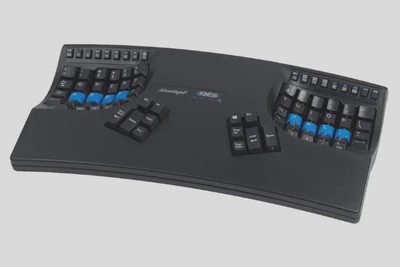
The keyboard is a critical, but often underappreciated part of an ergonomic workstation. The right keyboard reduces unnecessary stress to shoulders and wrists and significantly increases typing speed and convenience. I highly recommend the Kinesis Advantage 2 ergonomic keyboard. The Kinesis Advantage keyboard separates the keys into two groups, one for the left and one for the right hand, with space in the middle. The separate grouping allows the hands to be in a more natural position on the keyboard reducing stress to the body. The keyboard has a 3-dimensional layout, making the keys more reachable, more comfortable, and faster to type using all ten fingers. The keys use the Cherry MX brown switches, which require just the right amount of force for pleasant, fast typing.
We can use typing tutor software for practicing touch typing with an ergonomic keyboard. For example, I recommend the GNU typist software for learning to type with the Kinesis Advantage keyboard. It took me around four days to get to a comfortable skill level such that typing felt effortless and fast.
Mouse
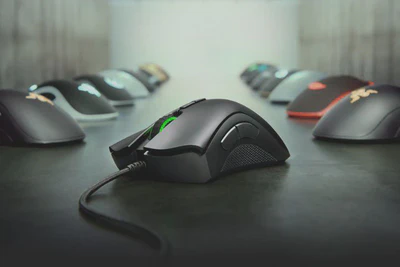
The mouse is also an essential part of the ergonomic workstation. An ergonomic mouse should fit the user’s hand and be fast and accurate. Gaming mouses are designed with these principles in mind because gamers play games for extended periods and playing games require speed and accuracy. My choice is the Razer Deathadder Elite, an ergonomic, fast, and accurate gaming mouse. It is also an excellent choice for knowledge workers due to its simple design as it has only the essential buttons.
Microphone
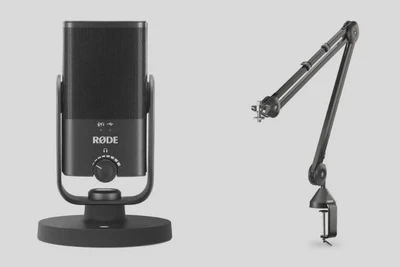
A studio microphone is an essential accessory for activities that require high-quality audio, such as recording videos, podcasting, live streaming, and video conferencing. High-quality audio makes the speaker’s sound feel professional and significantly more pleasant to listen to. My workstation includes the Rode NT-USB Mini is a portable, studio-quality USB microphone.
A studio arm is also a necessary part of a professional microphone setup. It allows the speaker to move the microphone close to their mouth without becoming an obstacle for the hands. High-quality studio arms are more stable compared to low-quality ones. I am using the Rode Professional Studio Boom Arm microphone arm.
Webcam
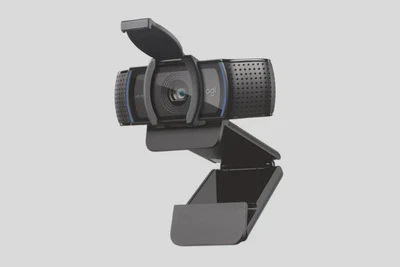
A webcam is also essential for video conferencing, live-streaming, and creating videos. As a side note, people with budget constraints should prioritize microphone quality over the webcam because the sound quality is more critical for these activities. I am using the Logitech C920s Pro, which is a popular choice for a webcam for streaming and recording video. However, for creating very high-quality videos you should consider using a real video camera. You can also improve your video quality with good lighting and positioning the camera well using a tripod. Try directing some light to your face using studio lights such as led panels – you will make a much better impression on people by not looking like a character from a horror film.
